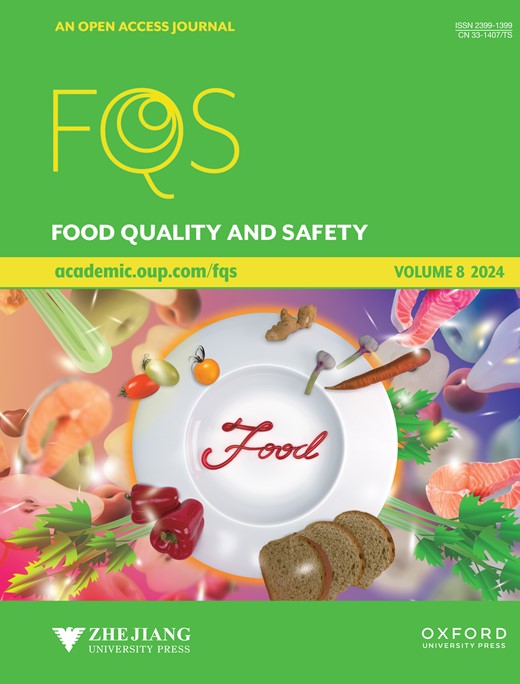Qualitative and quantitative analysis of β-sitosterol marker in virgin camellia oil and virgin olive oil
IF 4.4
3区 农林科学
Q2 FOOD SCIENCE & TECHNOLOGY
引用次数: 0
Abstract
Abstract Camellia oil and olive oil with superior economic value are easily adulterated with other, cheaper oils. It is difficult to identify both oils by traditional methods because of their similar fatty acid profiles. In the present study, a novel method for qualitative and quantitative analysis of β-sitosterol using GC/MS and GC/FID was developed to identify camellia oil and olive oil. The method validation of β-sitosterol analysis showed good linearity and satisfactory values for recovery, accuracy, precision, and repeatability. The linear regression coefficient (R2) of the calibration curve was 0.9985. An acceptable limit of detection (0.36 mg/100 g) and limit of quantification (1.20 mg/100 g) were achieved. The spiked recoveries were 95.0% to 100.3%. The relative standard deviation (RSD) of within-day precision was less than 3.26%, and the RSD of retention times and peak areas for repeatability were within 0.03% and 1.08%, respectively. The contents of β-sitosterol in virgin camellia oil and virgin olive oil were in the range of 14.1–30.2 mg/100 g and 94.3–173.2 mg/100 g, respectively, indicating that the β-sitosterol content in the former is seven times that in the latter, and β-sitosterol could be a potential marker for the authentication and adulteration detection of both oils.初榨茶油和初榨橄榄油中β-谷甾醇标记物的定性和定量分析
具有优越经济价值的茶油和橄榄油很容易与其他便宜的油掺假。由于两种油的脂肪酸谱相似,用传统方法很难对其进行鉴别。本研究建立了一种利用GC/MS和GC/FID对β-谷甾醇进行定性和定量分析的新方法,以鉴定油茶油和橄榄油。结果表明:β-谷甾醇分析方法线性良好,回收率、准确度、精密度和重复性良好。校准曲线的线性回归系数(R2)为0.9985。达到了可接受的检测限(0.36 mg/100 g)和定量限(1.20 mg/100 g)。加标回收率为95.0% ~ 100.3%。日内精密度的相对标准偏差(RSD)小于3.26%,重复性保留时间和峰面积的RSD分别小于0.03%和1.08%。初榨茶油和初榨橄榄油中β-谷甾醇的含量分别在14.1 ~ 30.2 mg/100 g和94.3 ~ 173.2 mg/100 g范围内,说明初榨茶油中β-谷甾醇的含量是初榨橄榄油的7倍,β-谷甾醇可作为两种油的鉴别和掺假检测的潜在标记物。
本文章由计算机程序翻译,如有差异,请以英文原文为准。
求助全文
约1分钟内获得全文
求助全文
来源期刊

Food Quality and Safety
FOOD SCIENCE & TECHNOLOGY-
CiteScore
7.20
自引率
1.80%
发文量
31
审稿时长
5 weeks
期刊介绍:
Food quality and safety are the main targets of investigation in food production. Therefore, reliable paths to detect, identify, quantify, characterize and monitor quality and safety issues occurring in food are of great interest.
Food Quality and Safety is an open access, international, peer-reviewed journal providing a platform to highlight emerging and innovative science and technology in the agro-food field, publishing up-to-date research in the areas of food quality and safety, food nutrition and human health. It promotes food and health equity which will consequently promote public health and combat diseases.
The journal is an effective channel of communication between food scientists, nutritionists, public health professionals, food producers, food marketers, policy makers, governmental and non-governmental agencies, and others concerned with the food safety, nutrition and public health dimensions.
The journal accepts original research articles, review papers, technical reports, case studies, conference reports, and book reviews articles.
 求助内容:
求助内容: 应助结果提醒方式:
应助结果提醒方式:


